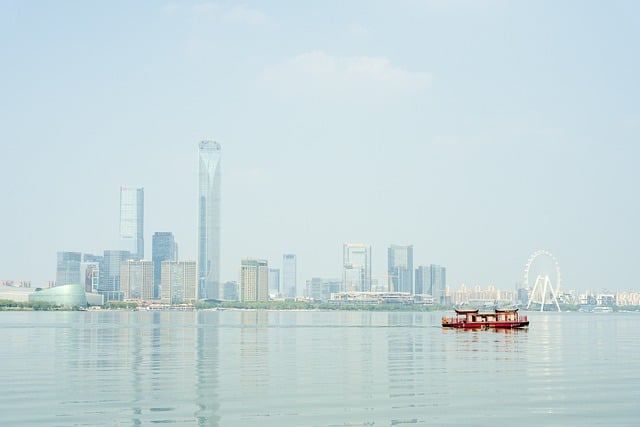In Karachi, stringent construction bylaws prioritize safety, order, and aesthetics, influencing project design through zoning, height limits, environmental factors, and noise control. Nazimabad, a rapidly growing neighborhood, has specific rules promoting sustainable development and preserving its unique character. These regulations guide developers, ensuring compliance for construction permits, while emphasizing fire safety, green spaces, and sustainable building practices. By balancing renewal with preservation, Nazimabad's potential is unlocked, creating a vibrant urban space that reflects Karachi's dynamic nature. Future trends include embracing sustainable technologies and digital transformation in project planning to support the city's growing real estate market.
“Unveiling the intricacies of construction bylaws in Karachi, this comprehensive guide offers a detailed exploration of Nazimabad’s influential role in shaping urban development regulations. From understanding the fundamental principles for builders and developers to analyzing the macro-impact on Karachi’s evolving landscape, we delve into key provisions and emerging trends. Discover how these bylaws navigate the delicate balance between urban growth and controlled development, offering both benefits and challenges along the way.”
- Understanding Construction Bylaws in Karachi: A Basic Guide
- The Role of Nazimabad in shaping construction regulations
- Key Provisions of By-laws Relevant to Builders and Developers
- Impact on Urban Development: Benefits and Challenges
- Future of Construction Governance: Trends in Karachi's Real Estate
Understanding Construction Bylaws in Karachi: A Basic Guide

In the bustling metropolis of Karachi, understanding construction bylaws is essential for any individual or entity involved in building projects. These regulations, designed to ensure safety, maintain order, and preserve the aesthetic appeal of the city, cover a wide range of aspects including zoning, building height limits, structural integrity, and noise pollution control. Knowing these laws not only helps in avoiding legal complications but also contributes to the overall development of the city in a structured and sustainable manner.
For instance, Karachi’s construction bylaws dictate specific guidelines for floor area ratios (FAR), ensuring that buildings do not overshadow neighboring structures. They also enforce strict rules regarding the use of space, with dedicated areas for residential, commercial, and industrial purposes. By adhering to these bylaws, developers can navigate the complex landscape of urban planning in Karachi, fostering a vibrant yet regulated environment that benefits both residents and investors alike.
The Role of Nazimabad in shaping construction regulations

Nazimabad, a vibrant and bustling neighborhood in Karachi, has played a pivotal role in shaping the city’s construction regulations. As one of the fastest-growing areas, it has experienced a surge in infrastructure development, leading to a complex web of bylaws and guidelines. The unique challenges posed by Nazimabad’s rapid urbanization have prompted local authorities to implement specific rules to ensure sustainable growth and maintain the area’s livability.
The construction bylaws of Nazimabad reflect a delicate balance between accommodating urban expansion and preserving the community’s character. These regulations cover various aspects, including zoning for residential, commercial, and industrial purposes, building height restrictions, and environmental considerations. By carefully navigating these rules, developers and builders can contribute to the area’s development while respecting its existing tapestry of culture and architecture, making Nazimabad a prime example of thoughtful urban planning in Karachi.
Key Provisions of By-laws Relevant to Builders and Developers

In the bustling metropolis of Karachi, the Nazimabad construction by-laws play a pivotal role in shaping the city’s architectural landscape. These by-laws are designed to ensure structured growth and maintain the aesthetic and functional integrity of residential areas. For builders and developers, understanding these key provisions is paramount. They dictate building heights, set back distances, and specify minimum space requirements for various amenities, ensuring each project aligns with the neighborhood’s character.
Relevant by-laws also cover safety measures, such as fire exits and emergency lighting, mandated to safeguard inhabitants. Additionally, they outline environmental considerations, including provisions for green spaces and sustainable building practices. Adherence to these regulations is crucial for obtaining construction permits, underscoring the importance of developers staying informed and compliant in the dynamic construction sector of Karachi.
Impact on Urban Development: Benefits and Challenges

The construction bylaws in Nazimabad, Karachi, have significantly shaped the urban development landscape of the city. These regulations play a pivotal role in ensuring structured growth, maintaining balance between modern infrastructure and historical heritage, and promoting sustainable practices. By setting guidelines for zoning, building heights, and material choices, the bylaws help preserve the aesthetic charm and cultural identity of Nazimabad while accommodating the needs of a growing metropolis.
However, implementing these bylaws presents its share of challenges. Balancing the desire for urban renewal with the preservation of historic areas can be a delicate task. Additionally, navigating bureaucratic processes and obtaining necessary approvals can delay construction projects, impacting the city’s overall development pace. Nevertheless, addressing these challenges is crucial to harness the full potential of Nazimabad, fostering a vibrant and harmonious urban environment that reflects Karachi’s dynamic character.
Future of Construction Governance: Trends in Karachi's Real Estate

The future of construction governance in Nazimabad, Karachi, mirrors trends across the city’s real estate sector. With rapid urbanization and a booming economy, Karachi is witnessing a surge in high-rise buildings and mixed-use developments. This shift towards vertical expansion presents both challenges and opportunities for effective construction management. One prominent trend is the increasing emphasis on sustainable building practices, driven by environmental concerns and government initiatives. Developers are incorporating green technologies, energy-efficient designs, and eco-friendly materials to meet evolving standards.
Additionally, digital transformation is reshaping the industry. Advanced software solutions, such as Building Information Modeling (BIM), are streamlining project planning, design, and collaboration. This enhances efficiency, reduces errors, and enables better cost control. As Karachi’s real estate market continues to grow, adopting innovative construction techniques and regulatory frameworks will be crucial to maintain a balanced and sustainable urban environment.
The construction bylaws of Nazimabad have played a pivotal role in shaping urban development in Karachi. By understanding these regulations, builders and developers can navigate the market more effectively, ensuring projects comply with key provisions. While the impact has been positive in terms of enhancing city aesthetics and infrastructure, challenges remain. Looking ahead, the future of construction governance in Karachi’s real estate sector is poised for further innovation, driven by evolving trends that promise to transform the landscape even further.



